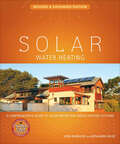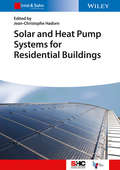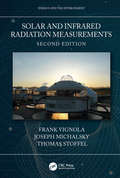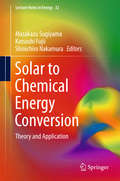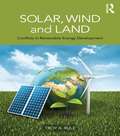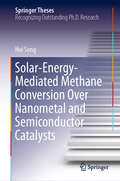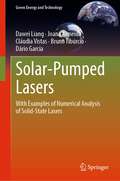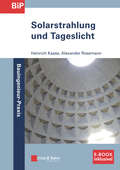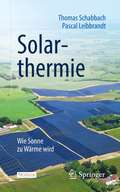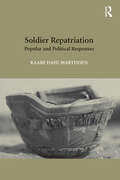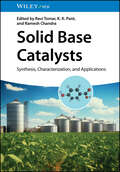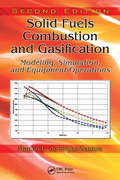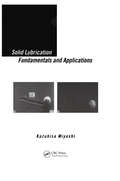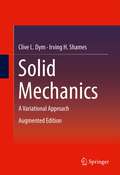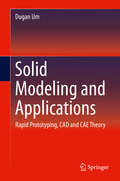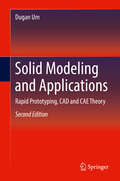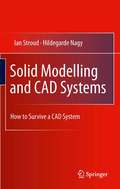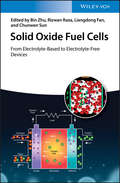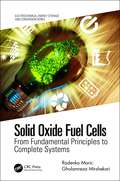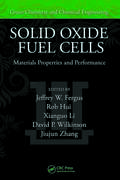- Table View
- List View
Solar Water Heating: A Comprehensive Guide to Solar Water and Space Heating Systems (Mother Earth News Books for Wiser Living)
by Bob Ramlow Benjamin NuszHeating water with the sun is a practice almost as old as humankind itself. Solar Water Heating , now completely revised and expanded, is the definitive guide to this clean and cost-effective technology. Beginning with a review of the history of solar water and space heating systems from prehistory to the present, Solar Water Heating presents an introduction to modern solar energy systems, energy conservation and energy economics. Drawing on the authors' experiences as designers and installers of these systems, the book goes on to cover:Types of solar collectors, solar water and space heating systems and solar pool heating systems, including their advantages and disadvantagesSystem components, their installation, operation, and maintenanceSystem sizing and sitingChoosing the appropriate system.This book focuses on the financial aspects of solar water or space heating systems, clearly showing that such systems generate significant savings in the long run. With many diagrams and illustrations to complement the clearly-written text, this book is designed for a wide readership ranging from the curious homeowner to the serious student or professional.
Solar and Heat Pump Systems for Residential Buildings (Solar Heating and Cooling)
by Jean-Christophe HadornThe combination of heat pumps and solar components is a recent development and has great potential for improving the energy efficiency of house and hot water heating systems. As a consequence, it can enhance the energy footprint of a building substantially. This work compares different systems, analyses their performance and illustrates monitoring techniques. It helps the reader to design, simulate and assess solar and heat pump systems. Good examples of built systems are discussed in detail and advice is given on how to design the most efficient system. This book is the first one about this combination of components and presents the state of the art of this technology. It is based on a joint research project of two programmes of the International Energy Agency: the Solar Heating and Cooling Programme (SHC) and the Heat Pump Programme. More than 50 experts from 13 countries have participated in this research.
Solar and Infrared Radiation Measurements, Second Edition
by Frank Vignola Joseph Michalsky Thomas StoffelThe rather specialized field of solar and infrared radiation measurements has become increasingly important due to the increased demands by the renewable energy and climate change research communities for data with higher accuracy and increased temporal and spatial resolutions. Recent advances in radiometry, measurement systems, and information dissemination also have increased the need for refreshing the literature available for this topic. This book provides the reader with an up-to-date review of the important aspects of solar and infrared radiation measurements: radiometer design; equipment installation, operation, maintenance, and calibration; data quality assessment parameters; and the knowledge necessary to properly interpret and apply the measured data to a variety of topics. Each of the authors has more than 40 years of experience with this subject, primarily as the result of developing and operating multiple measurement stations, working with the industry to improve radiometry, and conducting various research projects. The book’s scope and subject matter have been designed to help a wide audience gain a general understanding of this subject and to serve as a technical reference. A student new to the field will benefit from the review of terminology and the historical perspective for radiometry before addressing more detailed topics in radiometry that we hope will be of interest to the more experienced reader. Describes the strengths and weaknesses of irradiance instruments Provides detailed information on how to assess uncertainty in measurements Offers comprehensive background information needed to understand the use of solar instrumentation Discusses design concepts for shadowband radiometers, sky imagers, and satellite-based estimates of solar irradiance at the Earth’s surface Includes chapter-end questions, references, and useful links
Solar to Chemical Energy Conversion
by Masakazu Sugiyama Katsushi Fujii Shinichiro NakamuraThis book explains the conversion of solar energy to chemical energy and its storage. It covers the basic background; interface modeling at the reacting surface; energy conversion with chemical, electrochemical and photoelectrochemical approaches and energy conversion using applied photosynthesis. The important concepts for converting solar to chemical energy are based on an understanding of the reactions' equilibrium and non-equilibrium conditions. Since the energy conversion is essentially the transfer of free energy, the process are explained in the context of thermodynamics.
Solar, Wind and Land: Conflicts in Renewable Energy Development
by Troy A. RuleThe global demand for clean, renewable energy has rapidly expanded in recent years and will likely continue to escalate in the decades to come. Wind and solar energy systems often require large quantities of land and airspace, so their growing presence is generating a diverse array of new and challenging land use conflicts. Wind turbines can create noise, disrupt views or radar systems, and threaten bird populations. Solar energy projects can cause glare effects, impact pristine wilderness areas, and deplete water resources. Developers must successfully navigate through these and myriad other land use conflicts to complete any renewable energy project. Policymakers are increasingly confronted with disputes over these issues and are searching for rules to effectively govern them. Tailoring innovative policies to address the unique conflicts that arise in the context of renewable energy development is crucial to ensuring that the law facilitates rather than impedes the continued growth of this important industry. This book describes and analyses the property and land use policy questions that most commonly arise in renewable energy development. Although it focuses primarily on issues that have arisen within the United States, the book’s discussions of international policy differences and critiques of existing approaches make it a valuable resource for anyone exploring these issues in a professional setting anywhere in the world.
Solar-Energy-Mediated Methane Conversion Over Nanometal and Semiconductor Catalysts (Springer Theses)
by Hui SongThis book demonstrates that solar energy, the most abundant and clean renewable energy, can be utilized to drive methane activation and conversion under mild conditions. The book reports that coupling solar energy and thermal energy can significantly enhance methane conversion at mild temperatures using plasmonic nanometal-based catalysts, with a substantial decrease in apparent activation energy of methane conversion. Furthermore, this book, for the first time, reports the direct photocatalytic methane oxidation into liquid oxygenates (methanol and formaldehyde) with only molecular oxygen in pure water at room temperature with high yield and selectivity over nanometals and semiconductors (zinc oxide and titanium dioxide). These findings are a big stride toward methane conversion and inspire researchers to develop strategies for efficient and selective conversion of methane to high-value-added chemicals under mild conditions.
Solar-Pumped Lasers: With Examples of Numerical Analysis of Solid-State Lasers (Green Energy and Technology)
by Joana Almeida Dawei Liang Cláudia Vistas Bruno Tibúrcio Dário GarciaThis textbook is a comprehensive review of many different areas in solar-pumped lasers design and characterization. It enables readers to develop their skills in general solid-state laser design and solar collector design and provides numerous solved exercises at the end of each chapter to further this development. This book begins by introducing the brief history of solar-pumped laser and its potential applications. It explains the basic theories of imaging and non-imaging primary, secondary, and tertiary solar concentrators. It discusses solar-pumped solid-state laser theory and solar-to-laser power conversion efficiencies. There are chapters dedicated to ZEMAX and LASCAD numerical simulation tools, to help develop readers’ skills in innovative solid-state laser design. This book is one of the first books to relate concentrated solar energy technologies to solid-state laser technologies and is therefore of interest to students, academics, engineers, and laser and optical system designers.
Solar-to-fuel conversion in algae and cyanobacteria
by Cinzia FormighieriThis volume is focused on solar-to-fuel conversion using algae and cyanobacteria for advanced generation biofuels. Production of biofuels needs to rely on cheap and renewable resources, in order to be economically viable and environmentally sustainable in the long term. Solar energy is an abundant and renewable resource, and strategies for solar-to-fuel conversion have the potential to sustain our energy demands in the long term and to be carbon-dioxide neutral. First generation biofuels are those already on the market, such as bio-ethanol from sugarcane and corn starch, biodiesel from oil seed crops. However, development of a single biofuel, as efficient as it may be, would be insufficient and could not sustain the global demand for energy. The next generation of advanced biofuels explores alternative feedstocks and technologies, finding novel solar-to-fuel solutions. Algae and cyanobacteria can convert sunlight into chemical energy through the process of photosynthesis. They represent an alternative with respect to crops for solar-to-fuel conversion that does not compete with food for arable land. This SpringerBrief focuses only on solar-to-fuel conversion for production of advanced biofuels, pointing to the importance of relying on the sun for our sustainability in the long term. It is the only current publication to discuss the problem of light-utilization inefficiency during mass cultivation of micro-algae. This review also addresses the potential of cyanobacteria for the generation of direct photosynthesis-to-fuel platforms and discusses both possibilities and constraints for future developments.
Solarstrahlung und Tageslicht (Bauingenieur-Praxis)
by Heinrich Kaase Alexander RosemannDer Solarstrahlung kommt für das Leben auf der Erde die größte Bedeutung zu. Dieses Thema wird in diesem Buch aufgegriffen. Nach einer Beschreibung des Prozesses der Strahlungserzeugung und des Durchganges der Solarstrahlung durch die Erdatmosphäre werden die Wechselwirkungen durch physikalische, chemische, biologische und medizinische Effekte beschrieben. Da über verschiedene Formen der Sonnenenergiewandlung bereits eine kompetente Fachliteratur vorliegt, wird hier auf die entsprechenden Ausführungen verzichtet. Dagegen wird auf die Wirkungen über das menschliche Auge - also auf das Tageslicht - besonders eingegangen. Tageslicht als passive Solarstrahlungstechnik dient nicht nur der Beleuchtung von Innenräumen der Gebäude, es kann auch einen merklichen Anteil der Energieeinsparung liefern. Der Jahresumsatz der Energie eines Gebäudes hängt von den verwendeten wärmetechnischen Installationen, den architektonischen Gegebenheiten und der Kunstlichttechnik ab. So werden technische Lösungen sowie Komponenten beispielhaft zusammengestellt und Berechnungsverfahren und technische Regel angegeben. Besonderer Augenmerk wird auf eine qualifizierte, integrale Gebäudeplanung gelegt, die auf den Bedürfnissen der Nutzer basiert und somit nicht nur die energetische Gesamtbilanz verbessert, sondern gleichzeitig die Aufenthaltsqualität erhöht. Dieses Buch führt in die notwendigen physikalischen und meteorologischen Zusammenhänge von Solarstrahlung und Tageslicht ein, indem die doppelt spektralen Zusammenhänge von Strahlung und Effekt, wie die lichttechnischen und strahlungsphysikalischen Kennzahlen und die gesundheitlichen Wirkungen erläutert werden. Das Buch erläutert zudem Verfahren zur Bestimmung des Energieumsatzes mit Planungstools. Das Buch ist für Architekten, Bauingenieure, Gebäudetechniker, Lichttechniker, Arbeitsmediziner, Meteorologen und Umwelttechniker in Planungspraxis, Industrie, Forschung und Lehre geeignet.
Solarthermie: Wie Sonne zu Wärme wird (Technik im Fokus)
by Thomas Schabbach Pascal LeibbrandtWelchen Beitrag kann die Solarthermie zur Energiewende leisten? Was kostet Solarwärme und und wo sind ihre Grenzen?Nach einem kurzen Überblick über die Möglichkeiten regenerativer Wärmeversorgung führen die Autoren in die physikalischen Grundlagen der Solarstrahlung und der Strahlungswandlung ein. Dann erläutern sie die Funktionsweise der Solarkollektoren und der wichtigsten anlagentechnischen Komponenten anhand zahlreicher Abbildungen.Weitere Kapitel beleuchten die Einsatzmöglichkeiten und auch die Wirtschaftlichkeit solarthermischer Anlagen - von der Trinkwassererwärmung und Heizungsunterstützung bis hin zur Kühlung und zur Stromerzeugung.Das Buch vermittelt auch dem Laien einen guten Einstieg in diese wichtige und beim Umbau des Energiesystems unverzichtbare Technologie.
Solder Joint Reliability Assessment
by Mohd N. Tamin Norhashimah M. ShaffiarThis book presents a systematic approach in performing reliability assessment of solder joints using Finite Element (FE) simulation. Essential requirements for FE modelling of an electronic package or a single reflowed solder joint subjected to reliability test conditions are elaborated. These cover assumptions considered for a simplified physical model, FE model geometry development, constitutive models for solder joints and aspects of FE model validation. Fundamentals of the mechanics of solder material are adequately reviewed in relation to FE formulations. Concept of damage is introduced along with deliberation of cohesive zone model and continuum damage model for simulation of solder/IMC interface and bulk solder joint failure, respectively. Applications of the deliberated methodology to selected problems in assessing reliability of solder joints are demonstrated. These industry-defined research-based problems include solder reflow cooling, temperature cycling and mechanical fatigue of a BGA package, JEDEC board-level drop test and mechanisms of solder joint fatigue. Emphasis is placed on accurate quantitative assessment of solder joint reliability through basic understanding of the mechanics of materials as interpreted from results of FE simulations. The FE simulation methodology is readily applicable to numerous other problems in mechanics of materials and structures.
Soldier Repatriation: Popular and Political Responses
by Kaare Dahl MartinsenSoldier repatriation from Afghanistan has impacted debate about the war. This study highlights this impact with particular focus on Britain, Denmark and Germany. All three countries deployed soldiers soon after the 9/11 attacks, yet their role in Afghanistan and the casualty rates suffered, have been vastly different. This book looks at how their casualties influenced the framing of the war by analysing the political discourse about the casualties, how the media covered the repatriation and the burials, and how the dead were officially recognised and commemorated. Explaining how bodies count is not done exclusively by focusing on the political leadership and the media in the three countries, the response from the men and women in Afghanistan to the official framing of the war is given particular weight. Martinsen contributes to our understanding of European strategic culture by showing how countries respond to the same security challenges.
Solid Base Catalysts: Synthesis, Characterization, and Applications
by Ramesh Chandra K. K. Pant Ravi TomarFoundational knowledge and practical approaches of an interesting catalyst class for greener and cleaner chemical synthesis Solid Base Catalysts provides insights and information on cutting-edge heterogeneous catalysis technologies and approaches of non-corrosive and easy-to-use solid catalysts that can replace conventional liquid catalysts that are known to pose operational problems. Edited by three highly qualified authors with contributions from experts in industry and academia, Solid Base Catalysts includes: Latest and most advanced studies in the characterization of solid catalysts, with applications in various organic transformationsVersatile reaction types where solid catalysts can be used as well as the multidisciplinary nature of solid base catalyst research and its connections to other fieldsMulticomponent reactions for eco-compatible heterocyclic synthesis over solid catalysts and synthesis routes, experimental protocols, and other considerations for optimizing catalyst propertiesAdvanced methodologies and applications for analyzing solid catalysts and challenges and future prospects in the field Solid Base Catalysts is a complete reference on the subject for researchers and professionals in materials science, green chemistry, surface chemistry, and chemical engineering.
Solid Electrolytes for Advanced Applications: Garnets and Competitors
by Ramaswamy Murugan Werner WeppnerThis book highlights the state of the art in solid electrolytes, with particular emphasis on lithium garnets, electrolyte-electrode interfaces and all-solid-state batteries based on lithium garnets. Written by an international group of renowned experts, the book addresses how garnet-type solid electrolytes are contributing to the development of safe high energy density Li batteries. Unlike the flammable organic liquid electrolyte used in existing rechargeable Li batteries, garnet-type solid electrolytes are intrinsically chemically stable in contact with metallic lithium and potential positive electrodes, while offering reasonable Li conductivity. The book's respective chapters cover a broad spectrum of topics related to solid electrolytes, including interfacial engineering to resolve the electrolyte-electrode interfaces, the latest developments in the processing of thin and ultrathin lithium garnet membranes, and fabrication strategies for the high-performance solid-state batteries.This highly informative and intriguing book will appeal to postgraduate students and researchers at academic and industrial laboratories with an interest in the advancement of high energy-density lithium metal batteries
Solid Fuels Combustion and Gasification: Modeling, Simulation, and Equipment Operations Second Edition (Mechanical Engineering)
by Marcio L. de Souza-SantosAs an increasing number of professionals and graduate students enter the field of solid-based power generation, they all require an command of process and equipment, as well as the theory behind it all. However, their informational needs and understanding differ based on their experience and the task at hand.Solid Fuels Combustion and Gasification:
Solid Lubrication Fundamentals and Applications (Materials Engineering)
by Kazuhisa MiyoshiSolid Lubrication Fundamentals and Applications description of the adhesion, friction, abrasion, and wear behavior of solid film lubricants and related tribological materials, including diamond and diamond-like solid films. The book details the properties of solid surfaces, clean surfaces, and contaminated surfaces as well as discussing the structu
Solid Mechanics
by Clive L. Dym Irving H. ShamesSolid Mechanics: A Variational Approach, Augmented Edition presents a lucid and thoroughly developed approach to solid mechanics for students engaged in the study of elastic structures not seen in other texts currently on the market. This work offers a clear and carefully prepared exposition of variational techniques as they are applied to solid mechanics. Unlike other books in this field, Dym and Shames treat all the necessary theory needed for the study of solid mechanics and include extensive applications. Of particular note is the variational approach used in developing consistent structural theories and in obtaining exact and approximate solutions for many problems. Based on both semester and year-long courses taught to undergraduate seniors and graduate students, this text is geared for programs in aeronautical, civil, and mechanical engineering, and in engineering science. The authors' objective is two-fold: first, to introduce the student to the theory of structures (one- and two-dimensional) as developed from the three-dimensional theory of elasticity; and second, to introduce the student to the strength and utility of variational principles and methods, including briefly making the connection to finite element methods. A complete set of homework problems is included.
Solid Mechanics
by William HosfordHosford (emeritus, materials science, U. of Michigan), who has extensive publications in the field, has written a textbook focused on the mechanics of solids for students of mechanical engineering. Drawing much of the material from his earlier text, Mechanical behavior of materials, Hosford presents a clearly organized text that assumes students already have a knowledge of materials science and statics, allowing for an uncluttered presentation of the science, testing, and principles of stress and strain, elasticity, mechanical testing, plasticity, viscoelasticity, creep and stress rupture, ductility and fracture, and fatigue. Chapters on polymers, ceramics, and composites are included, as is a concluding chapter on anisotropy. Study problems are included throughout the text. Annotation ©2010 Book News, Inc. , Portland, OR (booknews. com)
Solid Modeling and Applications
by Dugan UmThe lessons in this fundamental text equip students with the theory of Computer Assisted Design (CAD), Computer Assisted Engineering (CAE), the essentials of Rapid Prototyping, as well as practical skills needed to apply this understanding in real world design and manufacturing settings. The book includes three main areas: CAD, CAE, and Rapid Prototyping, each enriched with numerous examples and exercises. In the CAD section, Professor Um outlines the basic concept of geometric modeling, Hermite and Bezier Spline curves theory, and 3-dimensional surface theories as well as rendering theory. The CAE section explores mesh generation theory, matrix notion for FEM, the stiffness method, and truss Equations. And in Rapid Prototyping, the author illustrates stereo lithographic theory and introduces popular modern RP technologies. Solid Modeling and Applications: Rapid Prototyping, CAD and CAE Theory is ideal for university students in various engineering disciplines as well as design engineers involved in product design, analysis, and validation.
Solid Modeling and Applications: Rapid Prototyping, Cad And Cae Theory
by Dugan UmThis updated, second edition provides readers with an expanded treatment of the FEM as well as new information on recent trends in rapid prototyping technology. The new edition features more descriptions, exercises, and questions within each chapter. In addition, more in-depth surface theory has been introduced in section four, with particular emphasis in surface theory. Promising cutting edge technologies in the area of rapid prototyping are introduced in section seven, MATLAB-based FEM analysis has been added in section eight, and development of the plan stress and plane strain stiffness equations are introduced as a new chapter. Revised and updated based on student feedback, Solid Modeling and Applications: Rapid Prototyping, CAD and CAE Theory is ideal for university students in various engineering disciplines as well as design engineers involved in product design, analysis, and validation. It equips them with an understanding of the theory and essentials and also with practical skills needed to apply this understanding in real world design and manufacturing settings.
Solid Modelling and CAD Systems
by Hildegarde Nagy Ian StroudSolid Modelling and CAD Systems gives users an insight into the methods and problems associated with CAD systems. It acts as a bridge between users who learn interfaces without understanding how they work and developers who create systems without understanding the needs of the users. The main feature of Solid Modelling and CAD Systems is a logical analysis of the techniques and basic solid modelling methods used in modern CAD systems. The book goes on to describe, among other subjects: two-dimensional shape definition methods,the command interface and graphics,databases and data exchange,early-phase design, andcommand files and command structures. Reading Solid Modelling and CAD Systems will help users understand the limitations of the techniques they are using and will enable practitioners to use CAD systems more efficiently. It is a valuable tool for designers, as well as for advanced undergraduate and postgraduate students. The exercises it contains allow readers to try out different aspects of the subject matter and the book also includes projects that can be used for teaching purposes.
Solid Oxide Fuel Cell Components
by Gurbinder KaurThis book examines the various interfacial reactions that take place when glass seals come into contact with components of SOFCs in reducing and oxidizing conditions. In developing an understanding of the structure and function of SOFCs, interfacial compatibility is an imperative criterion. This book addresses the technical challenges of developing sealants to avoid leakage losses at high operating temperatures, which are profoundly impactful to the efficiency of the fuel cell. This resource is important for anyone working with or studying fuel cell design and development, and is a pivotal source of cutting-edge information for research groups actively engaged in developing hermetic and stable seals which show minimum interfacial chemical reaction with interconnect and electrolyte.
Solid Oxide Fuel Cells: From Electrolyte-Based to Electrolyte-Free Devices
by Chunwen Sun Bin Zhu Rizwan Raza Liangdong FanPresents innovative approaches towards affordable, highly efficient, and reliable sustainable energy systems Written by leading experts on the subject, this book provides not only a basic introduction and understanding of conventional fuel cell principle, but also an updated view of the most recent developments in this field. It focuses on the new energy conversion technologies based on both electrolyte and electrolyte-free fuel cells?from advanced novel ceria-based composite electrolyte low temperature solid oxide fuel cells to non-electrolyte fuel cells as advanced fuel-to-electricity conversion technology. Solid Oxide Fuel Cells: From Electrolyte-Based to Electrolyte-Free Devices is divided into three parts. Part I covers the latest developments of anode, electrolyte, and cathode materials as well as the SOFC technologies. Part II discusses the non-electrolyte or semiconductor-based membrane fuel cells. Part III focuses on engineering efforts on materials, technology, devices and stack developments, and looks at various applications and new opportunities of SOFC using both the electrolyte and non-electrolyte principles, including integrated fuel cell systems with electrolysis, solar energy, and more. -Offers knowledge on how to realize highly efficient fuel cells with novel device structures -Shows the opportunity to transform the future fuel cell markets and the possibility to commercialize fuel cells in an extended range of applications -Presents a unique collection of contributions on the development of solid oxide fuel cells from electrolyte based to non-electrolyte-based technology -Provides a more comprehensive understanding of the advances in fuel cells and bridges the knowledge from traditional SOFC to the new concept -Allows readers to track the development from the conventional SOFC to the non-electrolyte or single-component fuel cell Solid Oxide Fuel Cells: From Electrolyte-Based to Electrolyte-Free Devices will serve as an important reference work to students, scientists, engineers, researchers, and technology developers in the fuel cell field.
Solid Oxide Fuel Cells: From Fundamental Principles to Complete Systems
by Radenka MaricSolid Oxide Fuel Cells: From Fundamental Principles to Complete Systems is as a valuable resource for beginners, experienced researchers, and developers of solid oxide fuel cells. It provides a fundamental understanding of SOFCs by covering the present state-of-the-art as well as ongoing research and future challenges to be solved. It discusses current and future materials and provides an overview of development activities with a more general system approach toward fuel cell plant technology, including plant design and economics, industrial data and advances in technology. Provides an understanding of the operating principles of SOFCs Discusses state-of-the-art materials, technologies and processes Includes a review of current industry and lessons learned Offers a more general system approach toward fuel cell plant technology, including plant design and economics of SOFC manufacture Covers significant technical challenges that remain to be solved Presents the status of government activities, industry and market This book is aimed at electrochemists, batteries and fuel cell engineers, alternative energy scientists, and professionals in materials science.
Solid Oxide Fuel Cells: Materials Properties and Performance
by Jiujun Zhang Jeffrey W. Fergus Xianguo Li David P. Wilkinson Rob HuiThe First Book Centered on Materials Issues of SOFCsAlthough the high operating temperature of solid oxide fuel cells (SOFCs) creates opportunities for using a variety of fuels, including low-grade hydrogen and those derived from biomass, it also produces difficulties in materials performance and often leads to materials degradation during operatio
